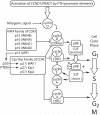Clinical and molecular genetics of parathyroid neoplasms
- PMID: 20833339
- PMCID: PMC2939004
- DOI: 10.1016/j.beem.2010.01.003
Clinical and molecular genetics of parathyroid neoplasms
Abstract
Primary hyperparathyroidism (HPT) results from the excessive secretion of parathyroid hormone from parathyroid tumours. While most HPT is sporadic, it is associated with a familial syndrome in a minority of cases. The study of these syndromes has helped define the pathophysiology of both familial and sporadic parathyroid neoplasms. Investigation of kindred with multiple endocrine neoplasia type 1 (MEN1) and the hyperparathyroidism-jaw tumour syndrome (HPT-JT) led to the discovery of the tumour suppressor genes MEN1 and HRPT2. We now recognise that somatic mutations in MEN1 and HRPT2 tumour suppressor genes are frequent events in sporadic parathyroid adenomas and carcinomas, respectively. Parathyroid tumours in the MEN2A syndrome result from mutational activation of the RET oncogene. The CCND1/PRAD1 oncogene was discovered by analysis of sporadic parathyroid tumours. Studies of familial isolated HPT and analysis of chromosomal loss and gain in parathyroid tumours suggest that other genes relevant to parathyroid neoplasia await identification.
Published by Elsevier Ltd.
Figures

References
-
- Fraser WD. Hyperparathyroidism. Lancet. 2009;374:145–58. - PubMed
-
- Westin G, Bjorklund P, Akerstrom G. Molecular genetics of parathyroid disease. World J Surg. 2009;33:2224–33. - PubMed
-
- Hunt JL. Molecular alterations in hereditary and sporadic thyroid and parathyroid diseases. Adv Anat Pathol. 2009;16:23–32. - PubMed
-
- Marx SJ. Molecular genetics of multiple endocrine neoplasia types 1 and 2. Nat Rev Cancer. 2005;5:367–75. * - PubMed
-
- Lemos MC, Thakker RV. Multiple endocrine neoplasia type 1 (MEN1): analysis of 1336 mutations reported in the first decade following identification of the gene. Hum Mutat. 2008;29:22–32. - PubMed
Publication types
MeSH terms
Substances
Grants and funding
LinkOut - more resources
Full Text Sources
Research Materials

